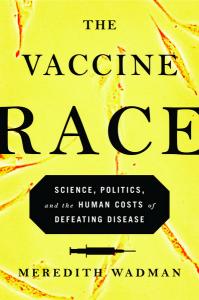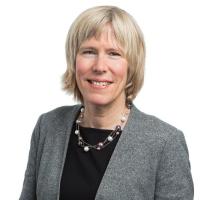Meredith Wadman: Vaccine Race
SCIENCE, POLITICS AND THE HUMAN COSTS
OF DEFEATING DISEASE
Meredith Wadman
Viking, February 7, 2017, $30.00
ISBN-10: 0525427538; ISBN-13: 978-0525427537
Ebook: ISBN: 978-1440843655
For this column, NASW book editor Lynne Lamberg asks NASW authors to tell how they came up with the idea for their book, developed a proposal, found an agent and publisher, funded and conducted research, and put the book together. She also asks what they wish they had known before they began working on their book, what they might do differently the next time, and what tips they can offer aspiring authors. She then edits the A part of that Q&A to produce the author reports you see here. Publication of NASW members’ reports in Advance Copy does not indicate NASW’s endorsement of their books. NASW welcomes your comments, and hopes this column stimulates productive discussions.
Wadman reports:
The Vaccine Race was born when I came across a letter published in Science in 2012, when I was working as a reporter for Nature. In it, a biologist named Leonard Hayflick argued that HeLa cells, made famous by Rebecca Skloot’s The Immortal Life of Henrietta Lacks, were not alone in having an amazing history: a cell line that he created from an aborted fetus in 1962 was used to make vaccines that have protected hundreds of millions of people. Not only that, Hayflick had gotten into a lawsuit-ridden fight with the U.S. government over who owned the cells, dubbed WI-38 — a fight that raised questions about tissue ownership that persist to this day.
Lifesaving vaccines; abortion; intellectual property wars — united by a cell line from a single fetus! That letter leapt off the page at me. Soon, I was out in California interviewing Hayflick in person. He was a treasure of a source, full of clear, cogent memories and feisty opinions. By the end of that trip, I knew that this story had to be a book.
I spent the next nine months, off and on, reporting and writing the story of the WI-38 cells as a feature article for Nature. I also found my agent, Gail Ross, who with her partner Howard Yoon provided hugely important help writing and shopping the book proposal in New York, where I signed a contract with Viking.Crucially, Gail also suggested that I apply for a New America Foundation fellowship. It funded me for two years of full-time work, after which I completed the book during a third, unfunded year. (New America has since made its fellowships part-time.)
What do I wish I had known or done differently? I can be my own worst enemy when I go down attractive-seeming research rabbit holes, getting fascinated by non-central characters and events. Yet in the end, this was part of the joy of writing the book, even if it added time to the process. I suppose, being me, that I couldn’t have done it any differently.
Contact info:
- Meredith Wadman, 703-343-3572, mwadman@gmail.com
- Book website: http://meredithwadman.com
- Agent: Gail Ross, 202-328-3282 , gross@rossyoon.com
- Publicist: Tony Forde (Viking), 212-366-2279, tforde@penguinrandomhouse.com
NASW members: will your book be published soon? Take advantage of this opportunity for shameless self-promotion. Submit your report for Advance Copy.
Tell your fellow NASW members how you came up with the idea for your book, developed a proposal, found an agent and publisher, funded and conducted research, and put the book together. Include what you wish you had known before you began working on your book, or had done differently.
See https://www.nasw.org/advance-copy-submission-guidelines.
Thinking of writing a book? If you are a NASW member, you may access a list of more than 150 books and online resources to help you craft your book proposal, find an agent and funding sources, negotiate your contract, learn about self-publishing, publicize and market your book, and more at https://www.nasw.org/article/write-book.
Send book info and questions about book publishing to Lynne Lamberg, NASW book editor, llamberg@nasw.org.





